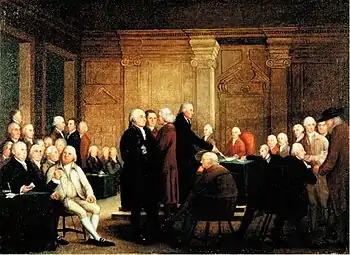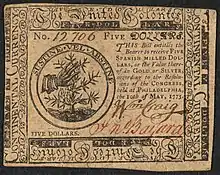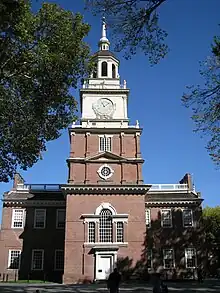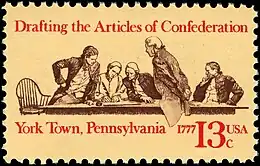Second Continental Congress
The Second Continental Congress was the late-18th-century meeting of delegates from the Thirteen Colonies that united in support of the American Revolution and its associated Revolutionary War that established American independence from the British Empire. The Congress created a new country that it first named the United Colonies, and in 1776, renamed the United States of America. The Congress began convening in Philadelphia, on May 10, 1775, with representatives from 12 of the 13 colonies, after the Battles of Lexington and Concord.
Second Continental Congress | |
|---|---|
| Part of the American Revolution | |
 | |
| Type | |
| Type | |
| History | |
| Established | May 10, 1775 |
| Disbanded | March 1, 1781 |
| Preceded by | First Continental Congress |
| Succeeded by | Congress of the Confederation |
| Leadership | |
Secretary | |
| Seats | Variable; ~60 |
| Meeting place | |
 | |
| Assembly Room, Pennsylvania State House, Philadelphia, Pennsylvania Under exigent circumstance also met at: Henry Fite House, Baltimore, Maryland; Court House, Lancaster, Pennsylvania; Court House, York, Pennsylvania; College Hall, Philadelphia, Pennsylvania | |
| This article is part of a series on the |
| United States Continental Congress |
|---|
 |
| Predecessors |
| First Continental Congress |
| Second Continental Congress |
| Congress of the Confederation |
| Members |
| Related |
|
|
The Second Continental Congress succeeded the First Continental Congress, which also met in Philadelphia from September 5 to October 26, 1774. The Second Congress functioned as the de facto national government at the outset of the Revolutionary War by raising militias, directing strategy, appointing diplomats, and writing petitions such as the Declaration of the Causes and Necessity of Taking Up Arms and the Olive Branch Petition.[1] All 13 colonies were represented by the time the Congress adopted the Lee Resolution, which declared independence from Britain on July 2, 1776, and the Congress unanimously agreed to the Declaration of Independence two days later.
Congress functioned as the provisional government of the United States of America through March 1, 1781. During this period, it successfully managed the war effort, drafted the Articles of Confederation and Perpetual Union, adopted the first U.S. constitution, secured diplomatic recognition and support from foreign nations, and resolved state land claims west of the Appalachian Mountains.
Many of the delegates who attended the Second Congress had also attended the First. They again elected Peyton Randolph as president of the Congress and Charles Thomson as secretary.[2] Notable new arrivals included Benjamin Franklin of Pennsylvania and John Hancock of Massachusetts. Within two weeks, Randolph was summoned back to Virginia to preside over the House of Burgesses; Hancock succeeded him as president, and Thomas Jefferson replaced him in the Virginia delegation.[3] The number of participating colonies also grew, as Georgia endorsed the Congress in July 1775 and adopted the continental ban on trade with Britain.[4]
History


%252C_by_John_Trumbull.jpg.webp)
De facto government
The First Continental Congress had sent entreaties to King George III to stop the Intolerable Acts. They also created the Continental Association to establish a coordinated protest of these acts, boycotting British goods in protest to them. The Second Continental Congress met on May 10, 1775, to plan further responses if the British government did not repeal or modify the acts; however, the American Revolutionary War had started by that time with the Battles of Lexington and Concord, and the Congress was called upon to take charge of the war effort.
For the first few months of the Revolutionary War, the patriots carried on their struggle in a largely ad-hoc and uncoordinated manner. Even so, they had numerous successes, seizing numerous British arsenals, driving royal officials out of several colonies, and launching the Siege of Boston in order to prevent the movement by land of British troops stationed there. On June 14, 1775, the Second Continental Congress voted to create the Continental Army out of the militia units around Boston, and the next day unanimously approved a motion naming George Washington of Virginia as its commanding general.[5][6]
On July 6, 1775, Congress approved a Declaration of Causes outlining the rationale and necessity for taking up arms in the Thirteen Colonies. Two days later, delegates signed the Olive Branch Petition to King George III affirming the colonies' loyalty to the crown and imploring the king to prevent further conflict. However, by the time British Colonial Secretary Lord Dartmouth received the petition, King George III had already issued a proclamation on August 23, 1775, in response to the Battle of Bunker Hill, declaring elements of Britain's continental American possessions to be in a state of what he called an "open and avowed rebellion". As a result, the king refused to receive the petition.[7]
Georgia had not participated in the First Continental Congress and did not initially send delegates to the Second. But with the Revolutionary War escalating, the residents of St. John's Parish in present-day Liberty County sent Lyman Hall to the gathering in Philadelphia on their behalf.[8] He participated in debates but did not vote, as he did not represent the entire colony.[9] That changed after July 1775, when a provincial Congress decided to send delegates to the Continental Congress and to adopt a ban on trade with Britain.[4]
The Continental Congress had no explicit legal authority from the British to govern,[10] but it assumed all the functions of a national government, including appointing ambassadors, signing treaties, raising armies, appointing generals, obtaining loans from Europe, issuing paper money called "Continentals", and disbursing funds. Congress had no authority to levy taxes and was required to request money, supplies, and troops from the states to support the war effort. Individual states frequently ignored these requests.
Congress was moving towards declaring independence from the British Empire in 1776, but many delegates lacked the authority from their home governments to take such drastic action. Advocates of independence moved to have reluctant colonial governments revise instructions to their delegations, or even replace those governments which would not authorize independence. On May 10, 1776, Congress passed a resolution recommending that any colony with a government that was not inclined toward independence should form one that was. On May 15, they adopted a more radical preamble to this resolution, drafted by John Adams, which advised throwing off oaths of allegiance and suppressing the authority of the Crown in any colonial government that still derived its authority from the Crown. That same day, the Virginia Convention instructed its delegation in Philadelphia to propose a resolution that called for a declaration of independence, the formation of foreign alliances, and a confederation of the states. The resolution of independence was delayed for several weeks, as advocates of independence consolidated support in their home governments.
On June 7, 1776, Richard Henry Lee offered a resolution before the Congress, declaring the colonies independent. He urged Congress to resolve "to take the most effectual measures for forming foreign Alliances" and to prepare a plan of confederation for the newly independent states.[11] Lee argued that independence was the only way to ensure a foreign alliance since no European monarchs would deal with America if they remained Britain's colonies. American leaders had rejected the divine right of kings in the New World, but recognized the necessity of proving their credibility in the Old World.[12]
Congress formally adopted the resolution of independence, but only after creating three overlapping committees to draft the Declaration, a Model Treaty, and the Articles of Confederation. The Declaration announced the states' entry into the international system; the model treaty was designed to establish amity and commerce with other states, and the Articles of Confederation established "a firm league" among the thirteen free and independent states. These [3]three things together constituted an international agreement to set up central institutions for conducting vital domestic and foreign affairs.[11] Congress finally approved the resolution of independence on July 2, 1776. They next turned their attention to a formal explanation of this decision, the United States Declaration of Independence which was approved on July 4 and published soon thereafter.
Provisional government
The Congress moved to Baltimore in the winter of 1776–77 to avoid capture by British forces who were advancing on Philadelphia. Henry Fite's tavern was the largest building in Baltimore at the time and provided a comfortable location of sufficient size for Congress to meet. Its site at the western edge of town was beyond easy reach of the British Royal Navy's ships should they attempt to sail up the harbor and the Patapsco River to shell the town. Congress was again forced to flee Philadelphia at the end of September 1777, as British troops seized and occupied the city; they moved to York, Pennsylvania, where they continued their work.
Congress passed the Articles of Confederation on November 15, 1777, after more than a year of debate, and sent it to the states for ratification. Approval by all 13 states was required for the establishment of the constitution. Jefferson's proposal for a Senate to represent the states and a House to represent the people was rejected, but a similar proposal was adopted later in the United States Constitution. One issue of debate was large states wanting a larger say, nullified by small states who feared tyranny. The small states prevailed, and each state was afforded one vote.[13] Another revolved around the issue of western land claims; states without such claims wanted those with claims to yield them to Congress. As written, western land claims remained in the hands of the individual states. Congress urged the states to give their assent quickly, and most did.[14] The first to ratify was Virginia on December 16, 1777; 12 states had ratified the Articles by February 1779, 14 months into the process.[15] The lone holdout, Maryland, finally ratified the Articles on February 2, 1781, doing so only after Virginia relinquished its claims on land north of the Ohio River to Congress.[14]
List of sessions


| May 10, 1775 – December 12, 1776 | |
|---|---|
| Location: | Pennsylvania State House, Philadelphia, Pennsylvania |
| President: | Peyton Randolph (until May 24, 1775)[16] John Hancock (from May 24, 1775)[16] |
| December 20, 1776 – February 27, 1777 | |
|---|---|
| Location: | Henry Fite House, Baltimore, Maryland |
| President: | John Hancock |
| March 5, 1777 – September 18, 1777 | |
|---|---|
| Location: | Pennsylvania State House, Philadelphia, Pennsylvania |
| President: | John Hancock |
| September 27, 1777 | |
|---|---|
| Location: | Court House, Lancaster, Pennsylvania |
| President: | John Hancock |
| September 30, 1777 – June 27, 1778 | |
|---|---|
| Location: | Court House, York, Pennsylvania |
| President: | John Hancock (until October 29, 1777)[16] Henry Laurens (from November 1, 1777)[16] |
| July 2, 1778 – July 20, 1778 | |
|---|---|
| Location: | College Hall, Philadelphia |
| President: | Henry Laurens |
| July 21, 1778 – March 1, 1781 | |
|---|---|
| Location: | Pennsylvania State House, Philadelphia, Pennsylvania |
| President: | Henry Laurens (until December 9, 1778)[17] John Jay (from December 10, 1778, until September 28, 1779)[17] Samuel Huntington (from September 28, 1779)[17] |
See also
- American Revolutionary War#Prelude to revolution
- Founding Fathers of the United States
- History of the United States (1776–1789)
- List of delegates to the Continental Congress
- Memorial to the 56 Signers of the Declaration of Independence
- State cessions
- Timeline of the American Revolution
- United Colonies
References
- Cogliano (2000), p. 113.
- Burnett, Edward Cody (1941). The Continental Congress. New York: Norton. pp. 64–67.
- Fowler, William M. Jr. (1980). The Baron of Beacon Hill: A Biography of John Hancock. Boston: Houghton Mifflin. p. 189. ISBN 0395276195.
- Cashin, Edward J. (2005). "Revolutionary War in Georgia". New Georgia Encyclopedia. Georgia Humanities and the University of Georgia Press. Retrieved April 22, 2019.
- Cogliano, Francis D. (2000). Revolutionary America, 1763–1815: A Political History. London & New York City: Routledge. p. 59. ISBN 978-0415180573.
- Marsh, Esbon R. (1941). "The First Session of the Second Continental Congress". The Historian. 3 (2): 188. doi:10.1111/j.1540-6563.1941.tb00537.x. JSTOR 24435926. Retrieved October 9, 2022.
- Maier, Pauline (1997). American Scripture: Making the Declaration of Independence. New York: Knopf. pp. 24–25, 249–250. ISBN 978-0679454922.
- Shippey, Judith A. (October 17, 2003). "Midway". New Georgia Encyclopedia. Georgia Humanities and the University of Georgia Press. Retrieved April 22, 2019.
- Deaton, Stan (September 12, 2002). "Lyman Hall (1724–1790)". New Georgia Encyclopedia. Georgia Humanities and the University of Georgia Press. Retrieved April 22, 2019.
- Bancroft, George (1874). History of the United States of America, from the discovery of the American continent. Boston, Massachusetts: Little, Brown and Company. p. 353. Retrieved April 22, 2019 – via Making of America digital library, University of Michigan Library.
- "The Declaration of Independence in World Context". Organization of American Historians, Magazine of History. 18 (3): 61–66. 2004. Archived from the original on July 3, 2015.
- Jones, Howard (2001). Crucible of power: a history of American foreign relations to 1913. ISBN 978-0842029186.
- Miller, John C. (1948). "22". Triumph of Freedom, 1775–1783. Little, Brown & Company. ISBN 978-1404748330.
- "Maryland finally ratifies Articles of Confederation". history.com. A&E Television Networks. Retrieved April 28, 2019.
- "Articles of Confederation, 1777–1781". Milestones in the History of U.S. Foreign Relations. Washington, D.C.: U.S. Department of State. Archived from the original on December 30, 2010. Retrieved April 28, 2019.
- Jillson, Calvin C.; Wilson, Rick K. (1994). Congressional Dynamics: Structure, Coordination, and Choice in the First American Congress, 1774–1789. Palo Alto, California: Stanford University Press. p. 77. ISBN 978-0804722933.
- Follett, Mary Parker (1909) [First edition, 1896]. The speaker of the House of Representatives. New York: Longmans, Greene, and Company. p. 337. Retrieved April 22, 2019 – via Internet Archive, digitized in 2007.
Further reading
- Adams, Willi Paul; Kimber, Rita (1980). The First American Constitutions: Republican Ideology and the Making of the State Constitutions in the Revolutionary Era. Rowman & Littlefield Publishers. ISBN 978-0742520691.
- Baack, Ben. "Forging a nation state: the Continental Congress and the financing of the War of American Independence." Economic History Review (2001) 54#4 pp: 639–656. online
- Davis, Derek H. Religion and the Continental Congress, 1774–1789: Contributions to Original Intent (Oxford University Press, 2000).
- Henderson, H. James (2002) [1974]. Party Politics in the Continental Congress. Rowman & Littlefield. ISBN 0819165255.
- Horgan, Lucille E. Forged in War: The Continental Congress and the Origin of Military Supply and Acquisition Policy (Greenwood, 2002).
- Irvin, Benjamin H. Clothed in Robes of Sovereignty: The Continental Congress and the People Out of Doors (Oxford University Press, 2011).
- Kruman, Marc W. (1997). Between Authority and Liberty: State Constitution Making in Revolutionary America. University of North Carolina Press. ISBN 0807847976.
- Montross, Lynn (1970) [1950]. The Reluctant Rebels; the Story of the Continental Congress. Harper. ISBN 038903973X.
- Rakove, Jack N. (1979). The Beginnings of National Politics: An Interpretive History of the Continental Congress. Knopf. ISBN 978-0394423708.
- Wilson, Rick K., and Calvin Jillson. "Leadership Patterns in the Continental Congress: 1774–1789." Legislative Studies Quarterly (1989): 5–37. online
Primary sources
- Burnett, Edmund Cody, ed. Letters of members of the Continental Congress (8 vol. Carnegie institution of Washington, 1921–1936) . online; also online edition
- Library of Congress, ed. Journals of the Continental Congress [=mediatype%3A%22texts%22 online]; also see table of contents
- Force, Peter (ed.). American Archives. Northern Illinois University Libraries. Archived from the original on February 6, 2007.
- Smith, Paul H., et al. eds. Letters of Delegates to Congress, 1774–1789 (24 volumes, (Washington, Library of Congress, 1978)
